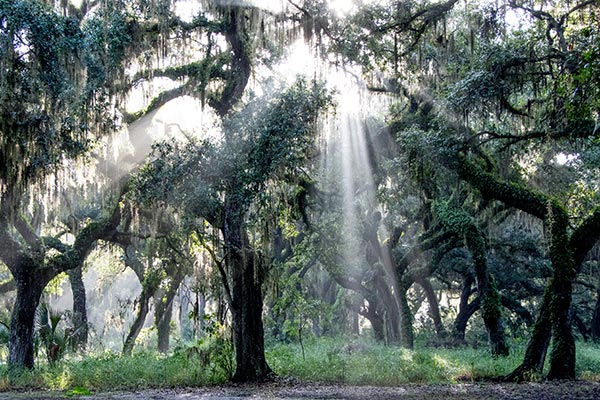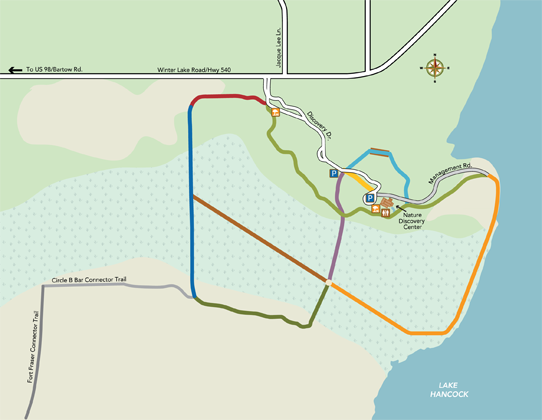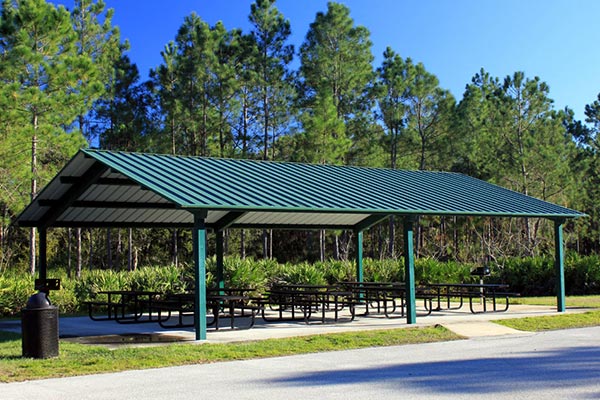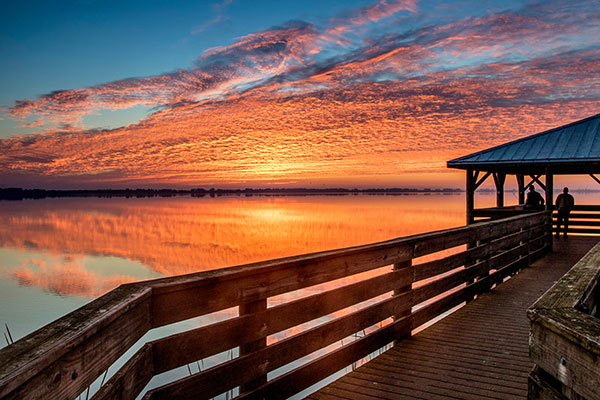Circle B Bar Reserve
Circle B Bar Reserve, on the northwest shore of Lake Hancock, is a former cattle ranch that today boasts a wide variety of plants and animals. You can see several distinct ecosystems in this reserve of 1,267 acres. You're almost guaranteed to see alligators in Lake Hancock, often considered the headwaters of the Peace River, which flows more than 100 miles from Polk County southwest to the Gulf of Mexico.
Circle B Bar Reserve is a nature reserve; please help protect the resident wildlife by following some basic rules while visiting, which include:
- No pets
- No balloons
- No music
We want everyone to enjoy what nature has to offer on its own.
Polk County and the Southwest Florida Water Management District acquired Circle B Bar Reserve in December 2000 to protect the valuable water and wildlife resources and to restore the Banana Creek marsh system.
It is important to note some trails may be periodically closed on any environmental land site for management and safety reasons. For a location map and additional information on Polk County Environmental lands, visit polknature.com. Those interested in obtaining additional information on trail closures should contact the Polk County Parks and Natural Resources Division at 863-668-4673.
Hiking
Circle B Bar Reserve has a series of maintained, marked trails of varying lengths. It's a half-mile hike to the lake, where you're sure to see alligators and other wildlife. Take your time on all the trails to soak in nature - there's lots to see.
Photography/Painting
The trail system provides countless opportunities for photographers and painters who seek to capture the beauty of nature. The abundance of birds and insects makes this location a favorite among nature artists. Please follow proper etiquette when photographing wildlife or plants, and remember not to put yourself or the subject at risk.
Picnic Shelters
There are five covered picnic areas with grills available on a first come, first serve basis. Two are located near the entrance and three around the Discovery Center.
Restrooms
Restrooms are located inside the Discovery Center and open during hours of operation. A portable restroom is located just southwest of the parking lots and available at all times.
Parking
Paved parking with handicapped-accessible areas, as well as grassy areas, are available.
Shady Oak Trail — (1.3 miles, Easy, Shaded)
This trail takes you through an oak hammock, where you can watch for cabbage palms wrapped in trumpet vines, live oak branches covered with resurrection ferns, Spanish moss and the butterfly orchid. The hammock provides food and shelter to many types of animals and birds.
Lost Bridge Trail — (0.5 miles, Easy, Mostly Shaded)
This trail leads you through an oak canopy to a long boardwalk that gives you a feeling of 'walking on water' through the swamp. The trail ends by taking you past the old cattle pens, a reminder of the past uses of this site.
Alligator Alley — (1 mile, Easy, Mostly Shaded)
This trail leads you through an oak canopy to a long boardwalk that gives you a feeling of 'walking on water' through the swamp. The trail ends by taking you past the old cattle pens, a reminder of the past uses of this site.
Marsh Rabbit Run — (0.7 miles, Easy, Partially Shaded)
This trail takes you past a shallow marsh where you may see many types of wading birds including spoonbills and white ibis. Several dead trees bear the chisel marks of red-bellied woodpeckers. Watch for otters and turtles using the fallen logs to bask in the sun. The former Banana Creek Canal runs along the south side of this trail.
Heron Hideout — (0.5 miles, Easy, Little Shade)
This trail crosses the marsh and can either return you to the Discovery Center or provide the shortest way to the marsh, where you can see birds like sandhill cranes, moorhens and black-necked stilts.
Eagle Roost — (0.7 miles, Moderate, No Shade)
This trail takes you through an uphill habitat under restoration with planted longleaf pines and wiregrass. Reptiles and birds such as bobwhite quails, eastern meadowlarks and American kestrels are commonly seen. Be sure to take water on this trail on hot summer days.
Wading Bird Way — (0.7 miles, Moderate, No Shade)
This trail runs along the deepest waters of the marsh system and boasts some of the best wildlife observations. Watch for great blue herons, great egrets and large groups of migratory wading birds such as the American white pelican.
Windmill Whisper — (0.4 miles, Moderate, Some Shade)
This trail takes you through an oak hammock that connects to Wading Bird Way and Shady Oak.
Otter Trail — (0.2 miles, Easy, Shaded)
This trail connects the Otter parking lot to the main parking lot at the Discovery Center.
Oak Hammock
As you enter this property, you'll see large oaks with branches full of Spanish moss and resurrection ferns. The size of the oaks and the deep green of the resurrection fern after a rain often overshadow the value of this habitat to wildlife. The hammock provides shade and shelter to wildlife during the heat of the day, from insects to cavity nesters such as the great horned owl.
Freshwater Wetlands
The most diverse wildlife areas are scattered seasonal marshes. These shallow wetlands harbor many insects and reptiles, which attract animals higher in the food chain, such as wading birds and alligators.
Banana Creek Marsh
This marsh area is composed of about 400 acres. Since earthwork restoration has been completed and some vegetation has been planted, new nesting and foraging sites for a variety of birds has been enhanced.
Wildlife
The ongoing restoration in the Banana Creek Marsh has provided foraging and breeding areas for a number of species never recorded on the site before. In 2008, the Reserve was added to the Great Florida Birding Trail. Be on the lookout for alligators, eagles, osprey, red shouldered hawks, wild turkey, barred owls, wood storks, white ibis, sandhill cranes, moorhens, pied-billed grebes, black-necked stilts, red-bellied woodpeckers, bobwhite quails, eastern meadowlarks, savannah sparrows, American kestrels, great blue herons, American white pelicans, sandpipers, spoonbills, great egrets, ducks and other waterfowl and wading birds. You might also see otters, bobcats, grey fox, armadillos, squirrels (gray and fox varieties), frogs, turtles, black racer snakes, five-lined racerunner lizards and other reptiles. Many migratory birds can be found here in the winter months.
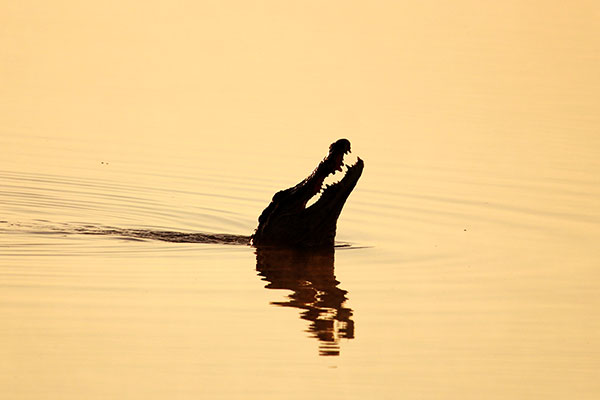
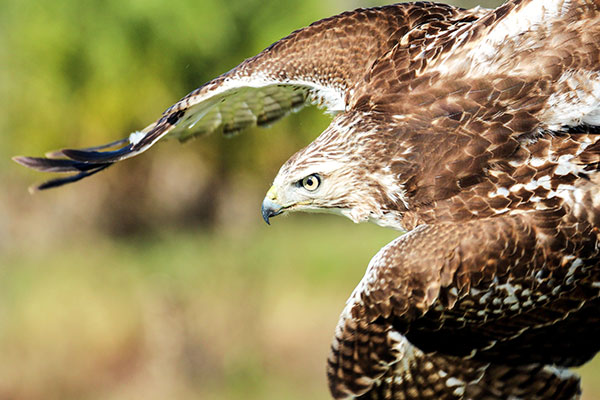
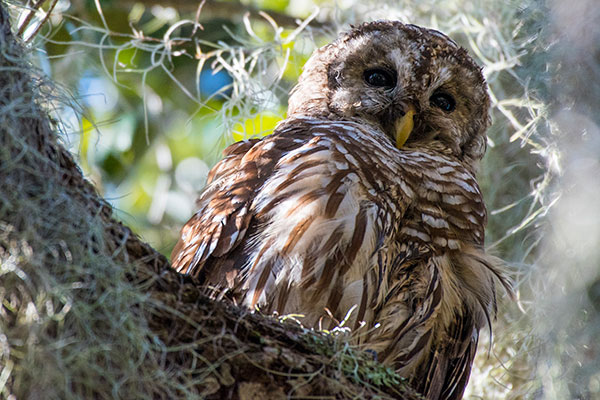
Wildflowers
The ecosystems of Circle B are historically composed of live oak hammocks, marsh and upland sandhill and sand pine scrub. The live oak hammock forms a canopy and is dominated by live oaks, Quercus virginiana and their epiphytes spanish moss, Tillandsia usneoides, resurrection fern, Pleopeltis polypodioides and butterfly orchid, Encyclia tampensis and the terristerial plant beggerweed, Desmodium incanum. The marsh has seasonal wet and dry periods and characteristically lacks trees. Plants characteristic of the marsh are alligator flag, Thalia geniculata, pickerelweed, Pontederia cordata and arrowheads Sagittaria spp. Sandhill and sand pine scrub ecosystems are systems found along the central Florida ridge, Ocala, Lake Wales and Lakeland ridges.
Like all pine communities, fire is needed to maintain the system. Sandhills occupy the highest points along the ridges and are characterized by having cream to clay colored sand. Once the most abundant ecosystem on the ridges but was a good place to grow citrus. Now sandhill are hard to find except in the Ocala National Forest. Characteristic sandhill trees include longleaf pine, Pinus palustris, broadleaf trees like turkey oak, Quercus laevis, bluejack or upland willow oak, Q. incana. Herbaceous plants include dog banana, Asimina reticulata, Florida paintbrush, Carphephorus corymbosum and sky blue lupine, Lupinus diffusus.
Sand pine scrub is characterized by having white sand and dominated by sand pine, Pinus clausa. It is said to be the oldest community found in Florida. The white sand allows rain water to filter quickly to the aquifer. The understory thickets are composed of scrub oaks, rusty lyonia, Lyonia ferruginea and a variety of lichens. Wildflowers consist of scrub mint Conradina grandiflora and garberia, Garberia heterophylla.
From the Polk Parkway:
Take exit No. 10, then turn south on U.S. 98 (Bartow Road). From U.S. 98, turn east on Winter Lake Road (State Road 540) and travel about 2 miles to the reserve's entrance on the south side
of the road.
From Bartow:
Travel north on U.S. 98 (Bartow Road), turn right on Winter Lake Road (State Road 540).
From Winter Haven:
Take State Road 540 (Winter Lake Road) west toward Lakeland. The entrance is located about 5 miles west of Spirit Lake Road.
Location
Address
4399 Winter Lake Rd.
Lakeland, FL 33803
Hours of Operation
6 a.m. — 6:30 p.m. (Standard Time)
5:30 a.m. — 8 p.m. (Daylight Savings Time)
In This Section
